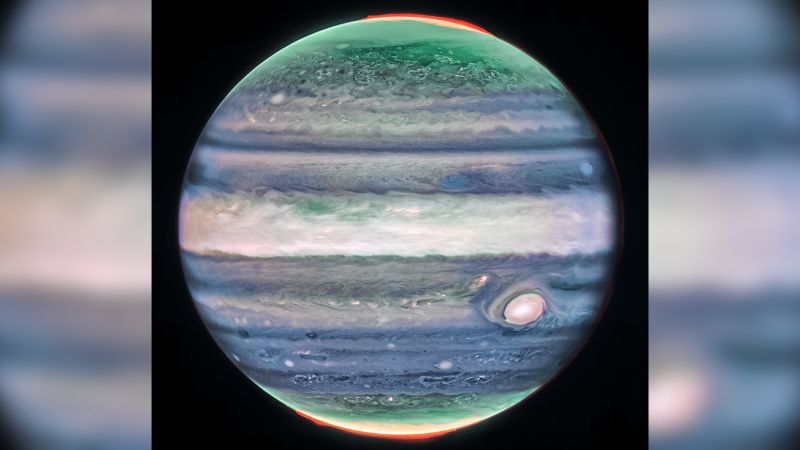NASA/ESA/CSA/STScI
The James Webb Space Telescope’s Near-Infrared Camera captured an image of Jupiter in infrared light. The bright white spots and streaks are likely high-altitude cloud tops of storms. Auroras, shown in red, can be seen around the poles.
Sign up for CNN’s Wonder Theory science newsletter. Explore the universe with news on fascinating discoveries, scientific advancements, and more.
CNN
—
Jupiter was one of the first targets observed by the James Webb Space Telescope when it initially turned its infrared gaze on the universe in July 2022. After capturing stunning images that surpassed the expectations of astronomers, the space observatory has now revealed a never-before-seen feature in the gas giant’s atmosphere.
Researchers used Webb’s Near-Infrared Camera, or NIRCam, to take a series of images of Jupiter 10 hours apart, applying four different filters to detect changes in the planet’s atmosphere. Infrared light is invisible to the human eye, and the Webb telescope’s unprecedented capabilities have been used over the past year to spot many newly observed celestial features, such as megaclusters of young stars and unexpected pairs of planet-like objects.
The astronomers spied a high-speed jet stream in Jupiter’s lower stratosphere, an atmospheric layer about 25 miles (40 kilometers) above the clouds. The jet stream, which sits over the planet’s equator, spans more than 3,000 miles (4,800 kilometers) wide and moves at 320 miles per hour (515 kilometers per hour), or twice the rate seen with sustained winds of a Category 5 hurricane on Earth.
The study findings, made possible by Webb’s sensitive capabilities, shed light on the dynamic interactions within Jupiter’s stormy atmosphere.
“This is something that totally surprised us,” said Ricardo Hueso, lead author of the study published October 19 in the journal Nature Astronomy, in a statement. Hueso is a physics lecturer at the University of the Basque Country in Bilbao, Spain.
“What we have always seen as blurred hazes in Jupiter’s atmosphere now appear as crisp features that we can track along with the planet’s fast rotation,” he said.
Jupiter is the largest planet in our solar system and is composed of gases, so it couldn’t be more different from Earth. But similar to our planet, Jupiter has a layered atmosphere. These turbulent layers have been observed by previous missions and telescopes attempting to better understand how the different parts of the atmosphere interact with one another. The layers also contain weather patterns, including century-spanning storms such as Jupiter’s Great Red Spot and clouds made of icy ammonia.
While other missions have penetrated deeper into Jupiter’s swirling clouds by using different wavelengths of light to peer beneath them, Webb is uniquely positioned to study the higher-altitude layers, about 15 to 30 miles (


